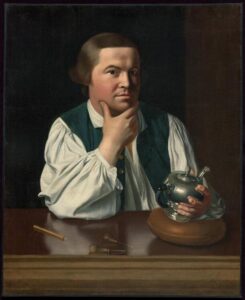
In 2026, the United States will commemorate the 250th anniversary (the “Semiquincentennial”) of its founding, the signing of the Declaration of Independence, and the onset of the American Revolution (“America250”). State and local governments, museums, historical associations, and other cultural and civic institutions across the country are developing programs designed to commemorate the importance of these historic events. To many, America250 presents a once-in-a-generation opportunity to share the whole history of our nation and to foster dialogue and narrative about the nation’s story – good, bad, and ambivalent.
Among other projects, the Museum of Fine Arts, Boston will commemorate America250 by reinstalling eight 18th-century Art of the Americas galleries. The MFA’s diverse collection of 18th century American art, which is one of the broadest and most important in the world, includes paintings, sculptures, furniture, decorative arts, and works on paper ranging in date from 1680 to 1820. The current installation was completed in 2010 and features iconic works from the early American period and focuses on stories of Paul Revere, John Singleton Copley, and traditional heroes of the Revolution. The reimagined and reinstalled galleries will include many of these important works but also will reflect the museum’s broader collection of early American art from across North, Central, and South America and the Caribbean, including Indigenous and island nations.
The ideas and content for the reinstallation are being developed by the MFA curatorial team in concert with scholars, artists, Native knowledge holders, educators, and community leaders. The current plan is to organize the new galleries around multiple key themes: Power and Resistance; History or Myth?; Asian Influences in the Americas; Communities of Makers; John Singleton Copley; Boston’s World: Tea, Mate, Chocolate, and Coffee; and Homes and Families. The galleries, which will be on view for the next 15 to 20 years, will invite the museum’s one million annual visitors to consider the following key ideas:
- the interplay and encounter of the diverse cultures active in the 18th-century Americas – Native and non-Native, North and South American, enslaved and free – as reflected in the arts
- stories of cultural exchange and interdependence, rather than the standard narratives of independence
- the diverse range of materials, techniques, artists, and patrons that animated the arts in the 18th-century Americas
- the role of the arts in shaping our understanding of the nation’s founding, and our broader ideas about the Americas and Americanness – “as a place, an identity, and an aspiration.”
The museum hopes that the reinstallation will enable all visitors to the galleries to experience a broader and more inclusive history of the 18th century through engagement with its rich collection of American art.
In February 2025, the Americana Foundation awarded a two-year, $75,000 grant to support the reinstallation project. Americana’s grant complements a $250,000 grant awarded by the Henry Luce Foundation in June 2024.
Click here for more information about MFA Boston's reimagining of the Art of the Americas wing.
